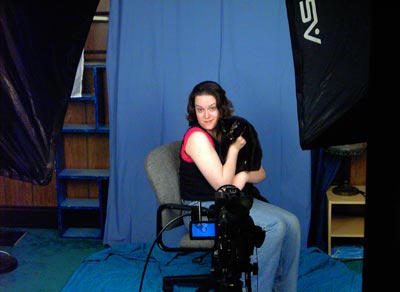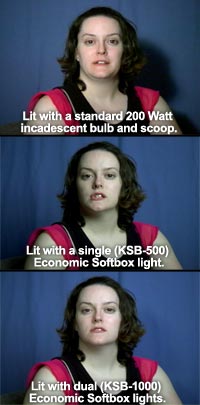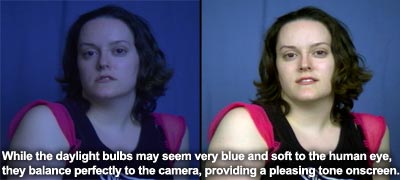Review from Micro Film Maker Magazine
 |
| KSB-1250 ECONOMY SOFTBOX LIGHT KIT |
Many video folks may not be as familiar with Smith-Victor as they are with companies like Arri or Lowell, or even smaller companies like Alzo, that are well known in the video/motion film lighting world. However, traditional still photographers are very familiar with Smith-Victor, as they are one of the dominant names in still photography lighting. A few years back, Smith-Victor decided to apply their vast knowledge of lighting to the motion world and have since released a number of video lights. Fortunately for our readers, these lights are substantially less expensive than most of their competitors!
More recently, Smith-Victor decided to enhance this cost-effective mentality by making a line of video lights with an even greater eye for economy called their KSB series. These are soft box lights which are designed to be used primarily as fill lights, where the diffusion that’s a part of the softbox shell disperses light evenly across a subject. These lights are designed to be easy to use, economical to acquire, and economical to continue using.
With these goals in mind, we immediately contacted Smith-Victor about reviewing their new set of lights. They kindly provided us with the two light setup of the KSB-1000. A single light setup is available as the KSB-500 and a three light setup is available as the KSB-1250 (which consists of two main lights and a softer 250W overhead softbox setup, for a form of three point lighting).

Ease of UseOnce you have the lights where you want them, adjusting them and aiming them is very easy. They adjust up to nine feet in height, which allows you get a little height on a scene if you need to. (The boom arm for the smaller softbox in the KSB-1250 will presumably let you get even higher, but I’m sure this setup would require sandbag placement to prevent the rig from becoming overly top heavy.)
If you’ve never set up a soft box before, opening up the box for one of the KSB lights may be a little confusing, as it looks almost exactly like you just opened up the box for a pup tent. Much like a pup tent, creating the rigging for a softbox is about bending tension rods into fabric pockets and then securing the outer shell around it. While I have been on shoots with soft box lighting, I hadn’t constructed one myself, so found it took a little bit of work to accomplish. (Our problems stemmed from the fact that we received a pre-production version of the KSB-1000 for this review which did not have instructions. All the production released versions have instructions in them as of press time, so I’m sure this won’t be an area of confusion by the time you read this.)
Once you get the soft boxes constructed, they’re a bit awkward to move around in an indoor setting, as their sheer size makes them a bit awkward to move through doorways. You can get them through, but it is a little bit of a pain. Because of the effort required to assemble the softbox, you may want to keep them assembled most of the time.
Depth of Options
Soft boxes are never lights that give you a huge number of options, as they are designed to throw a lot of diffuse light on a scene, rather than have the pinpoint accuracy that’s seen in more conventional video and film lights. As I mentioned before, the height options give you some variance, as can additional distance. However, due to the less powerful bulbs used in these lights, additional distance is often not the best option, as due to the quickness of light falloff.
 They experimented with the idea of putting a second sheet of diffusion inside the softbox, to allow one light to be softer than the other without requiring the light be moved away from the action. However, they found that the hotter bulbs that are used in the KSB series, caused this second sheet of diffusion to become too hot for use. (Because we received the pre-production version, we accidentally received the internal diffusion they had been testing as well.) The idea is great but because of the internal temperature issue, it would be great to see an outer silk diffusion included. This would be slightly larger than the face of the soft box and could velcro to the outside of the softbox to give you the double diffusion that you may want in certain situations.
They experimented with the idea of putting a second sheet of diffusion inside the softbox, to allow one light to be softer than the other without requiring the light be moved away from the action. However, they found that the hotter bulbs that are used in the KSB series, caused this second sheet of diffusion to become too hot for use. (Because we received the pre-production version, we accidentally received the internal diffusion they had been testing as well.) The idea is great but because of the internal temperature issue, it would be great to see an outer silk diffusion included. This would be slightly larger than the face of the soft box and could velcro to the outside of the softbox to give you the double diffusion that you may want in certain situations.The bulbs that come with this package are 500W bulbs (or 250W for the top light in the KSB-1250) which are balanced at the 3200K tungsten light temperature, meaning that they are balanced perfectly to simulate artificial, indoor lighting. If you wish to use these lights to replicate daylight, you can pick up a set of 5200K temperature fluorescent bulbs directly from Smith-Victor, which worked quite well in our tests. They’re especially useful if you need to light in an indoor location that you want to look as though it was all naturally lit. (Be aware that daylight temperature bulbs have a blue hue, which, in a fluorescent bulb, appears a bit soft and watery to the human eye. However, once you white balance your camera accordingly, colors actually pop a little more with these daylight bulbs.)
One thing I would love to see in a future version of this series is a squared surrounding scoop which would wrap around the bulb and which the material of the softbox would extend from. If this can be done without posing a fire risk, then it could behave like a camera matte box. This would allow filmmakers to put in rigid colored filters and have additional color options.
Performance
This set worked quite well for video work and even film work. The pictures included with this review were shot with a DVX100 that was using the Redrock Micro 35mm adapter, which cuts nearly two f-stops of light sensitivity from the DVX100.
The spring steel staves that give the softbox its shape stayed flexible and didn’t warp with use, even when, under one of our tests, we had it hold its shape for a month. The stands are well constructed, although they did bow a bit when fully extended. I would like to see a little thicker construction of the stands in future versions to eliminate this problem. Still, this is a fairly small issues and did not get in the way of the overall performance of the softbox.

Value
Ranging from $219 for the single light KSB-500 to $559 for the triple light KSB-1250, these lights are very economical and throw out a decent amount of light onto your subjects.
Perhaps even more important than the initial cost of the lights is the cost of bulbs that the lights use. Many professional light rigs can have bulbs in the hundreds of dollars range. While the 500W 3200K bulbs used by the KSB-1000 will burn out before those more expensive bulbs, the are only $6 a piece to replace, so the cost of operation is amazingly cheap! If you want to use this setup to provide daylight to a scene, the daylight bulbs are a bit pricier at $50 a pop. However, the good thing is that because these daylight bulbs are specially designed and balanced fluorescents, they burn much cooler and last 8000 hours. (This means that you could actually leave these lights on 24 hours a day for nearly a year!) Just make sure you don’t touch the bulbs with your bare hands when you’re swapping between the two options, as the oils from your hands are not good for bulbs.
Final Comments
If you need a solid lighting solution that is readily affordable, even with micro-budgets, then the Economy SoftBox series of lights from Smith-Victor might just be the perfect solution. Plus, with inexpensive incandescent bulbs and long-lasting fluorescent bulbs, the cost to use these lights for the long haul won’t break the bank either!
| ||||||||||||||










0 comments:
Post a Comment